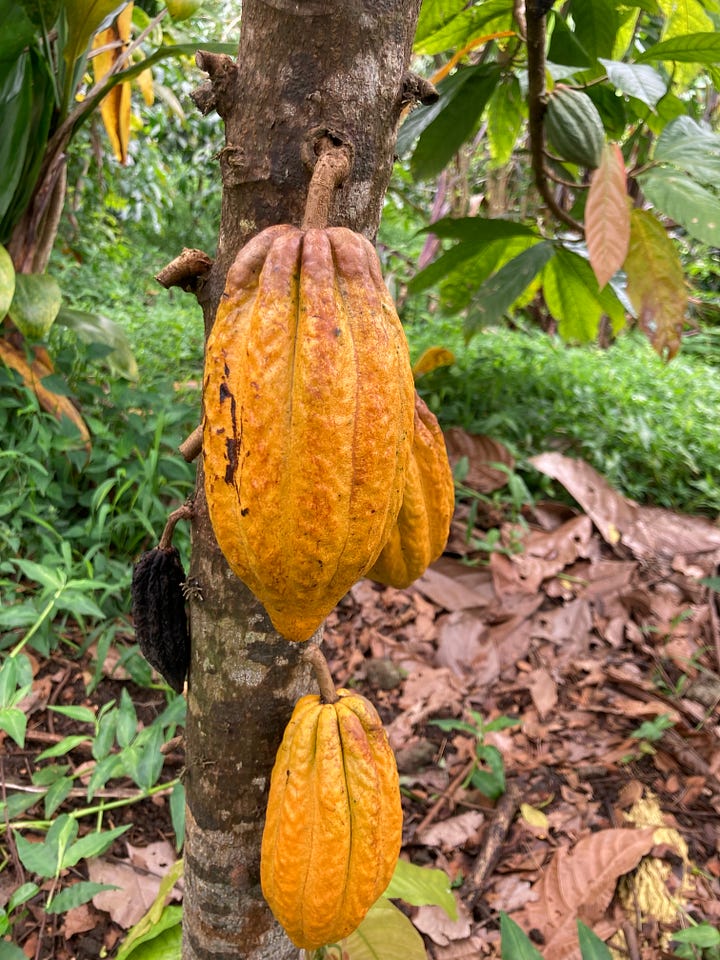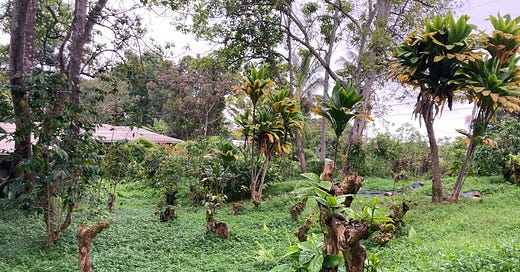The Hawaii Paradox
The place where the climate crisis is most real to me is the same place most people go to escape it.
Dear friends,
I’m writing from my family’s farm in Kona, Hawaii, where I’ve spent the last two weeks. Here, the noisy coqui frogs go to bed last, the roosters wake up first, and the sun is much hotter than it used to be.
It’s so hot, in fact, that I can often feel the moisture around me evaporating as I walk up and down the sloped piece of land. Even during rainy season, young plants can start to wither within 12 hours of rainfall.
“The rain didn’t make it to the roots,” my mother says of the latest brief downpour as she rushes to water the vegetables she has transplanted in the garden. This time of year, her moods are closely linked to the rain gauge.


But the heat isn’t all she and my stepfather have to contend with these days. Despite nearing retirement, they are in a constant dance to keep up with a dramatic set of changes wrought by the climate crisis. Just when they change everything to accommodate a new pest or invasive species* on their five-acre organic farm, another one arrives to upset the balance. And the warming temperature isn’t the only factor; the resulting loss of native forest and irregular weather patterns are playing a significant role in making the state much less stable
In just the last few years, the coffee, macadamia nuts, and avocados—two cash crops and one of their staple foods—have all been hit by new pests that have dramatically reset their expectations. Thanks to coffee leaf rust, many the trees have lost leaves or died, and their 2022 coffee harvest was only 10 percent of what it used to be. This year, after much effort and investment, they’re hopeful it might bounce back to 30 percent.
Until two years ago, avocados used to be so plentiful that they could choose only the most delicious trees for harvesting. Then the avocado lace bug moved in, and now they’re lucky if they can find one or two each week. And just last year, two of the beautiful old macadamia nut trees at the top of the farm succumbed to a disease that causes macadamia quick decline (not to be confused with Rapid ʻŌhiʻa Death, which is killing native trees across the island at a rapid clip). Meanwhile, the mosquito population is moving up the mountains, threatening to do away with Hawaii’s last remaining native birds (more on that soon).
Most of this tumult is invisible to the 3,000–4,000 people who travel to Hawaii island every day. That number pales in comparison to the visitors to Oahu and Maui; nonetheless, at one of the most picturesque beaches on the island, you can stand in some of the most beautiful cerulean water and watch a new airplane appear in the sky overhead every 30 minutes.
Many of those visitors stay at the resorts along the northern coast or drive air-conditioned rental cars in a loop around the island before they pick up and leave again 10 days later. To them, it’s as if Hawaii is a mirage that disappears as soon as the wheels on their planes pick up off the tarmac.
It’s strange and disheartening to be here—where the impacts of climate change are unfolding faster and more visibly than they are in many places, at a time of record-breaking planetary heat on land and in the ocean—and yet be surrounded by people who are intentionally putting their real lives on pause. And it’s especially strange to consider that some of those folks come here, in part, to escape from heatwaves, flooding, wildfire smoke, and other forms of air pollution made worse by the climate crisis.
The question at the heart of so much right now seems to be: Will we make changes on our own terms, or will we wait until we have no choice but to change?
On my family’s farm, it’s a lot of both right now. Many of the old coffee trees are being replaced with tropical black walnuts, cacao, and new macadamia nuts and coffee varieties, which we hope will weather the next phase of climactic change. It’s the best bet, given the circumstances, but for my parents, the shift comes with a hefty dose of grief and anxiety about what lies ahead. In our family, we talk often about whether keeping the farm is a risk worth taking. Come 10 years from now, none of us knows whether it will it be a place to escape to—or a place to escape from.
How are you seeing climate change play out in your home town? I’d be curious to hear about it in the comments.
Climate news you may have missed
The limits of the green tech boom
Bill McKibben’s much-shared New Yorker piece does such a respectable job of succinctly laying out the tension between degrowth advocates and those who are moving forward with the potentially massive shift to clean tech, arguing that while we don’t have time to avoid the latter, it won’t ultimately work without also consuming less and restructuring systems of ownership power. He writes:
“It would be a shame to waste the vast effort simply trying to re-create our current society on a lower-carbon basis, because we’d soon run into the other barriers that the degrowth activists warn of, from too much nitrogen to too little solidarity. Instead of halting the build-out of green energy, it would be wise to use that enormous process, one of the biggest economic shifts in human history, to nudge our societies toward greater equality and greater conviviality.”
While I found the piece a little breezy given the high stakes—I’d argue that justice is a more important initial goal than conviviality, for example—I appreciate McKibben’s effort to find a third option in a very polarized debate.
Nearly every big lobbyist is working for fossil fuel companies
Or that was my takeaway from the coverage of a new database tracking the work of 1,500 lobbyists who represent fossil fuel companies in Washington D.C.
F Minus, the group behind the database, found that these same lobbyists were all also working for other entities, “ranging from the city governments of Los Angeles, Chicago and Philadelphia; tech giants such as Apple and Google; more than 150 universities; some of the country’s leading environmental groups—and even ski resorts seeing their snow melted by global heating.” While these double-agent powerbrokers can’t legally lobby both sides of a single piece of legislation, there’s nothing that prevents them from working with warring parties.
This means that “neutral” lobbying firms are essentially playing—and profiting from—both sides. And while there many people who lobby lawmakers, it’s telling that large environmental groups turn to these large firms because they’re the ones who have built power in D.C.
On the flip side, it benefits the firms to have clients in the arts, as well city governments and conservation groups. As James Browning, creator of the database says, those other clients can “cloak their radical agenda in respectability.”
Fireflies
Fireflies—arguably one of the most magical parts of summer in the northern hemisphere—have been slowly disappearing in many places. The Washington Post recently produced a beautiful multimedia package on the topic, but the short list of “solutions" the paper recommends caught my attention. In addition to recommending that readers turn off their outdoor lights and let their lawns grow tall, there’s a quick mention of reducing broad-spectrum insecticides, presumably in reader’s backyards. And while all of that would certainly help, the absence of any mention of farms—which use a great deal of insecticides—or the link between the food we eat and the so-called “insect apocalypse” is a little surprising. This 2019 interview between Anna Lappé and the lead author behind the landmark study in insect disappearance sheds more light on the topic.
CO2 pipelines are a triple threat
What does carbon capture have to do with ethanol? Plenty, it turns out. Last year’s climate bill, the Inflation Reduction Act, ushered in billions in tax credits that may flow to the ethanol industry for storing its CO2 biproduct underground—and sending it through massive pipelines along the way.
As I see it, ethanol is already an Emperor’s New Clothes industry: We now use almost 30 percent of the corn we grow in the U.S. to make this alternative to gasoline, and that has led more farmers to blanket radically more acres in corn, even though there’s evidence that ethanol’s full lifecycle results in more emissions than gasoline. But because the industry is seen as having saved farmers—and whole communities—from corn prices that would otherwise make growing the crop untenable, it has maintained a kind of halo in rural America.
Now, the pipeline construction boom is ratcheting up the stakes. NPR ran a stark story last month that likened a dangerous recent pipeline leak to a zombie apocalypse, and it has helped fire up pipeline opponents, many of whom are land owners in the proposed path of the pipelines. They are calling for a pipeline moratorium in five states, though it’s unclear whether they’ll be able to make a significant dent in the plans. While opponents are focused on the danger caused by the pipeline leaks, it’s just as dangerous that pipelines could further expand the demand for corn production—which is terrible for everything from biodiversity to land access—while also furthering the idea that storing carbon is a viable alternative to cutting oil and gas production. It’s not.
On the brighter side
On Monday, a federal court temporarily halted construction of the Mountain Valley Pipeline (aka Manchin’s pipeline) while they hear testimony about the constitutionality of its passage within the larger debt-ceiling deal.
Climate activists shut down Wimbledon and gained national coverage.
And San Francisco has become a model for localized water re-use, and all new buildings of a certain size must now have their own on-site recycling and grey water systems for toilets and landscaping. “Eventually,” reads the story in Yes! Magazine, “it’s hoped that buildings will be completely self-sufficient, or ‘water neutral,’ using the same water over and over, potable and nonpotable, in a closed loop.”
The Visual



1. A floating gas station, as imagined by Yellow Dot Studios.
2. A beautiful, subversive bird's nest made from anti-bird spikes, collected by biologist Auke Florian.
3. Kílian Jornet, celebrity trail runner, adds his voice to the opposition to the Rosebank oil and gas field.
Top header image by Mara Greenaway.
*I’m still not sure what I think about this term. But that’s fodder for another newsletter.






So hard to read what's happening on the farm juxtaposed with the vivid image of planes arriving every 30 minutes. I have been rethinking travel and where my line is as far as deciding what type of travel justifies (in my mind) spewing more carbon into the air. I can't imagine what it feels like to not know if your family home will be a refuge or a place of danger in 10 years. Thank you for taking all the headlines (many that I missed) and making the connections you make and seeing the patterns that are hard to spot when doomscrolling.
I really appreciate this inside view, as painful as it is. And whoa with the lobbyists all working for fossil fuel companies--you're really filling in the big picture of what is blocking systemic change.